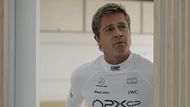In the newly released F1: The Movie, Brad Pitt is doing more than just driving; he’s defying physics, logic, and retirement age in one swift turn of the wheel. Enter Sonny Hayes: a former Formula 1 hotshot dragged out of the shadows and flung back onto the world’s fastest stage to mentor a rookie and revive the underdog team, Apex GP. With real race footage, pit crews, and the blessing of Lewis Hamilton himself, the film blurs the line between documentary-level realism and turbocharged fiction.
But here’s the twist: Is Sonny Hayes’ return to elite racing plausible within the cutthroat, physically demanding world of modern Formula 1? Here’s a breakdown of just how believable Pitt’s comeback storyline really is. Time to pop the hood and see if this storyline runs on logic, or just pure Hollywood fuel.
Brad Pitt's racing career in F1: The Movie

In the film, Brad Pitt's Sonny Hayes is shown as a veteran Formula One driver who drove in the 1990s alongside legendary drivers like Ayrton Senna. Known as one of the most notorious drivers of his time, after a terrible accident on the track where he doesn't get help from anyone, he retires from racing and starts living a life of gambling in a van, occasionally driving in smaller-scale races, almost always winning them. He is then hired by his old teammate, Ruben Cervantes, to race for his team APXGP, which is performing terribly in the championships and is close to getting sold.
Although reluctantly, Hayes agrees to join F1 again and is placed alongside rookie Joshua Pearce. They have a strained relationship, with the latter often being too competitive and arrogant against Pitt's Hayes, leading to issues within the team, and an injury that temporarily makes Pearce unable to drive. The film also explores Hayes' internal struggles and his passion for racing and how his past has changed him as a person. All in all, the film does an accurate, although rather dramatic, portrayal of the sport and the sportsmen, sprinkled with enough real-life cameos from the real F1 world, to make you believe that you're actually watching a championship.
However, questions have arisen about whether Pitt's storyline is realistic enough. Can a person in his 60s actually race in Formula One? Can a veteran rejoin the racetrack after being off it for three decades? Here's what the filmmakers have said.
How logical is Brad Pitt's storyline in terms of actual F1 rules?

Pitt is 61 years old in real life. But the film does not, in any way, mention his age. It just mentions that he raced in the 1990s, which could make him anywhere from his late 40s to his 60s. Formula One has a minimum age requirement of a player being 18 years old, and 17 if they are exceptionally talented and promising. There is no maximum limit in terms of age for the sport, although the oldest F1 racer was Louis Chiron, who was almost 65 years old when he raced in the 1955 Monaco Grand Prix.
Toto Wolff, the principal of the Mercedes team, has talked about Pitt's age in the film and told TIME magazine,
“I don’t think Sonny is 61,”
Next question. Can a person who retired thirty years ago restart racing in F1? Short answer? Yes. Long answer? It would be difficult, yes, but not impossible. The rules around the sport, the vehicles, styles, players, and tactics- all of it has revolutionized a lot in three decades. So it's a little Hollywood magic for (spoiler alert!) Hayes to win races against stars like Max Verstappen and Lewis Hamilton.
However, Toto says that it's not impossible.
“Racing cars is like learning to ride a bicycle. You don't unlearn that.”
The film does show Pitt struggling at first, but he does get on track rather immediately. That would be highly unlikely for a driver to achieve in such a short time. Anyways, the film is as close to realism as it could be, thanks to Hamilton's constant involvement in the project and all the effort it went into the cinematography for the film, that you're almost googling about APXGP.
How realistic is F1: The Movie in other terms?

For anyone who has not followed the sport religiously, the film will appear to fall back in a few areas. The plotline is, of course, exaggerated for dramatic purposes, and a lot of real-life technical stuff is sidelined. Hollywood hits the gas hard in some corners. Brad Pitt's fairytale return to the grid, an idea that, in real life, would get laughed out of the paddock. The inclusion of a female technical director is a hopeful glimpse at where the sport could go, not where it is now. And the dramatic crashes? More edge-of-your-seat than Pitt Wall realistic.
However, the realistic factor of the film is pretty high. It is shot during actual Grand Prix weekends with Brad Pitt himself blazing down real circuits in a souped-up F2 car masquerading as a Formula 1 beast. The result? A visual feast of roaring engines, real trackside chaos, and pit lane tension so palpable it might leave tire marks on your screen.
And the script doesn’t coast either. It revs straight from F1 history, nodding to iconic moments like Jenson Button’s rain-soaked 2011 Canada win, the scandalous Crashgate drama, and bone-chilling wrecks that reshaped careers. Ferrari board member Eddy Cue even claimed that every plot beat is inspired by something that’s actually happened. The characters? Fictional, yes, but instantly familiar to anyone who’s ever watched a race, with the strategies, the rivalries, the pressure cooker energy of a Sunday race, all being spot on.
Still, F1 doesn’t pretend to be a documentary. It’s a love letter, an homage to the sport, rooted in rubber-burning truth, turbocharged with fantasy, and built to leave your pulse racing. Although certain parts might appear a little dreamy, Hollywood makes it seem all possible, with Brad Pitt making it look believable and convincing.
Released on June 27, 2025, you can catch F1:The Movie now in theaters.
Love movies? Try our Box Office Game and Movie Grid Game to test your film knowledge and have some fun!
